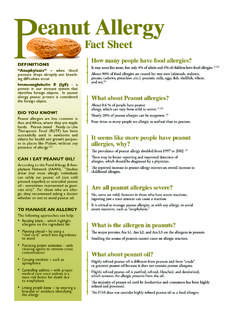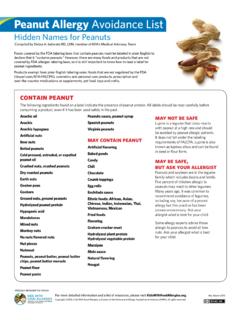Transcription of Ara Peanut - questprimaryinsights.com
1 Peanut allergen component testing Ara h8. Peanut Ara h9. allergens Ara by the h1. numbers Ara h2. Ara h3. Detect sensitizations to the whole Peanut to create personalized management plans for your patients. High levels of Peanut IgE. can predict the likelihood of Peanut sensitivity, Ara but may not be solely h8. predictive of reactions or allergic LOWER RISK of systemic reaction2. R. isk of mild, localized symptoms, such as itching/tingling of the lips, Peanut allergen mouth, and oropharynx3. C. ross-reactive with pollens ( , birch)3. component testing Measurement of specific IgE by blood Ara h8.
2 Test that provides objective assessment of sensitization to the whole Peanut is the first step in discovering the likelihood of +. a systemic reaction and the necessary precautions that may be prescribed. Knowing to which protein your patient is sensitized can help you develop a management ,2,8-10. +/- of Peanut sensitive patients +/- may not be at risk for a systemic Ara h1 Ara Determine which h2 proteins your patient Ara Ara is sensitized to. h9 h3. VARIABLE RISK. of systemic reaction HIGHER RISK. of systemic reaction Reduce patient including anaphylaxis4 including anaphylaxis6,7 anxiety with Often accompanied by sensitization to other Sensitization to Ara h2 is nearly always associated individualized Peanut proteins5 with clinical Peanut allergy2.
3 Management plans. Cross-reactive with fruits with pits ( , peaches)4. Ara h9 Ara h1, 2, 3 Test interpretations and next steps Oral food challenge (OFC) with a specialist may be recommended. High likelihood that patient may pass OFC. - - If patient passes an OFC: Foods prepared with or around peanuts may be consumed Patient not restricted to Peanut -free zones 5 I f there is no clinical history of + - symptoms, please see considerations above 6 I f there is a clinical history of symptoms, please see considerations below Choose Peanut -free zones +/- +. for patient's safety Prescribe epinephrine auto-injector Family, colleagues, and teachers should be made aware of allergy and have a plan As in all diagnostic testing, a diagnosis must be made by the physician based on test results, individual patient history, the physician's knowledge of the patient, and the physician's clinical judgement.
4 Diagnose Assess Address Enable by the risks anxiety confidence numbers. for systemic with individualized in dietary and reactions and management plans. lifestyle choices. cross-reactivity. Test Name Test Code Test Name Test Code Childhood allergy Profile Food allergy Profile w/Reflexes -D.. pteronyssinus (House mite), (NTC-2721) d1; D. farinae (House -C. ontains all components of the Food allergy Profile (NTC-10715). mite), (NTC-2722) d2; Cat dander, (NTC-2601) e1; Dog dander, with reflex to the following components, with reflex to Egg (NTC-2605) e5; Egg white, (NTC-2801) f1; Milk, (NTC-2802) f2; Component Panel, (NTC-91372); Ovomucoid, (NTC-3046) f233.
5 Codfish, (NTC-2803) f3; Wheat, (NTC-2804) f4; Peanut , (NTC-2813) 10659 91682. Ovalbumin, (NTC-2719) f232; Milk Component Panel, (NTC-91403);. f13; Soybean, (NTC-2814) f14; Shrimp, (NTC-2824) f24; Walnut, Casein, (NTC-2853) f78; Alpha-lactalbumin, (NTC-2851) f76; Beta- (NTC-3489) f256; Cockroach, (NTC-2736) i6; Cladosporium lactoglobulin, (NTC-2852) f77; Peanut Component Panel, (NTC- herbarum, (NTC-2702) m2; Alternaria alternata, (NTC-2706) m6; 91681) Ara h1, f422; Ara h2, f423; Ara h3, f424; Ara h8, f352; Ara h9. Total IgE. Nut Mix Group 18. Childhood allergy Profile w/Reflexes - I gE allergy testing for: Almond, (NTC-2820) f20; Cashew nut, (NTC- -C.)
6 Ontains all components of the Childhood allergy Profile (NTC- 2608) f202; Coconut, (NTC-2836) f36; Hazelnut, (NTC-2817) f17; 7918. 10659) with reflex to the following components, Egg Component Peanut , (NTC-2813) f13; Pecan, (NTC-2864) f201; Sesame seed, Panel, (NTC-91372); Ovomucoid, (NTC-3046) f233; Ovalbumin, 91683 (NTC-2810) f10. (NTC-2719) f232; Milk Component Panel, (NTC-91403); Casein, (NTC-2853) f78; Alpha-lactalbumin, (NTC-2851) f76; Beta- Nut Panel lactoglobulin, (NTC-2852) f77; Peanut Component Panel, (NTC- -M. acadamia nut, (NTC-38475); Pecan, (NTC-2864); Brazil nut, 91681) Ara h1, f422; Ara h2, f423; Ara h3, f424; Ara h8, f352; Ara h9 (NTC-2818); Walnut, (NTC-3489); Cashew nut, (NTC-2608); 94462.
7 Pistachio, (NTC-2726); Hazelnut, (NTC-2817); Almond, (NTC-2820);. Food allergy Panel Peanut no reflexes (NTC-2813). -M. ilk, (NTC-2802) f2; IgE Egg white, (NTC-2801) f1; IgE Peanut , (NTC-2813) f13; IgE Walnut, (NTC-3489) f256; IgE Corn, (NTC-2808) Nut Panel w/Reflexes 38767. f8; IgE Wheat, (NTC-2804) f4; IgE Soybean, (NTC-2814) f14; IgE -M. acadamia nut, (NTC-38475); Pecan, (NTC-2864); Brazil nut (with Codfish, (NTC-2803) f3; IgE Clam, (NTC-8929) f207; IgE Shrimp, reflex), (NTC-94464); Walnut (with reflex), (NTC-94467); Cashew (NTC-2824) f24; Total IgE 94463. nut (with reflex), (NTC-94465); Pistachio, (NTC-2726); Hazelnut (with reflex), (NTC-94468); Almond, (NTC-2820); Peanut (with Food allergy Profile reflex), (NTC-91747).
8 -E. gg white, (NTC-2801) f1; Milk, (NTC-2802) f2; Codfish, (NCT-2803). f3; Wheat, (NTC-2804) f4; Corn, (NTC-2808) f8; Sesame seed, Peanut Component Panel 10715 91681. (NTC-2810) f10; Peanut , (NTC-2813) f13; Soybean, (NTC-2814) f14; -A. ra h1, f422; Ara h2, f423; Ara h3, f424; Ara h8, f352; Ara h9. Shrimp, (NTC-2824) f24; Clam, (NTC-8929) f207; Walnut, (NTC- 3489) f256; Scallop, (NTC-273) f338 Peanut (Total) w/Reflex -P. eanut, f13; *Positive result reflexes to 91681 Peanut 91747. Component Panel, (Ara h1, f422; Ara h2, f423; Ara h3, f424; Ara h8, f352; Ara h9). Multiple test codes are available.
9 Refer to the Quest Diagnostics Directory of Services or the online Test Center ( /testcenter). for test information. NTC = National test code For more information about Peanut component testing, contact your local sales representative. References 1. Nicolaou N, Poorafshar M, Murray C, et al. allergy or tolerance in children sensitized to Peanut : prevalence and differentiation using component-resolved diagnostics. J allergy Clin Immunol. 2010;125(1):191-197. 2. Asarnoj A, Nilsson C, Lidholm J, et al. Peanut component Ara h 8 sensitization and tolerance to Peanut . J allergy Clin Immunol.
10 2012;130(2):468-472. 3. Mittag D, Akkerdaas J, Ballmer-Weber BK, et al. Ara h 8, a Bet v 1-homologous allergen from Peanut , is a major allergen in patients with combined birch pollen and Peanut allergy . J allergy Clin Immunol. 2004;114(6):1410-1417. 4. Lauer I, Dueringer N, Pokoj S, et al. The non-specific lipid transfer protein, Ara h 9, is an important allergen in Peanut . Clin Exp allergy . 2009;39(9):1427-1437. 5. Mov rare R, Ahlstedt S, Bengtsson U, et al. Evaluation of IgE antibodies to recombinant Peanut allergens in patients with reported reactions to Peanut . Int Arch allergy Immunol.




